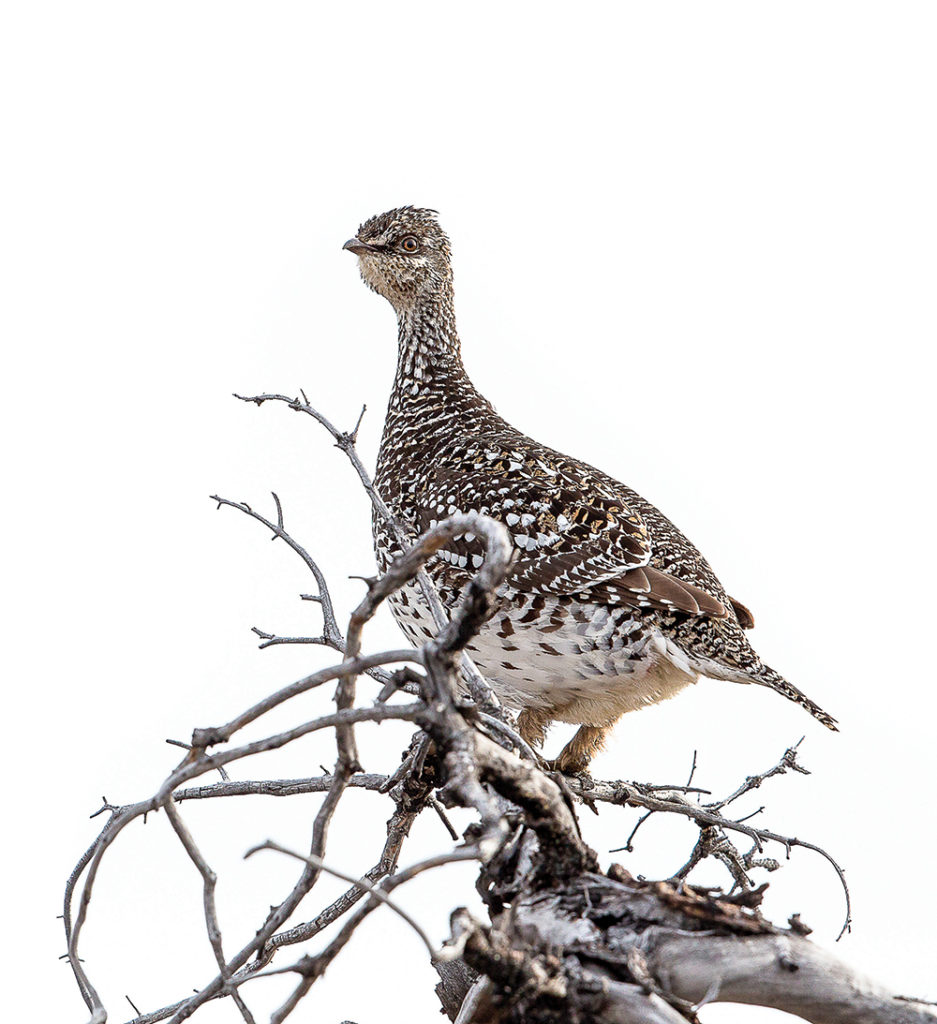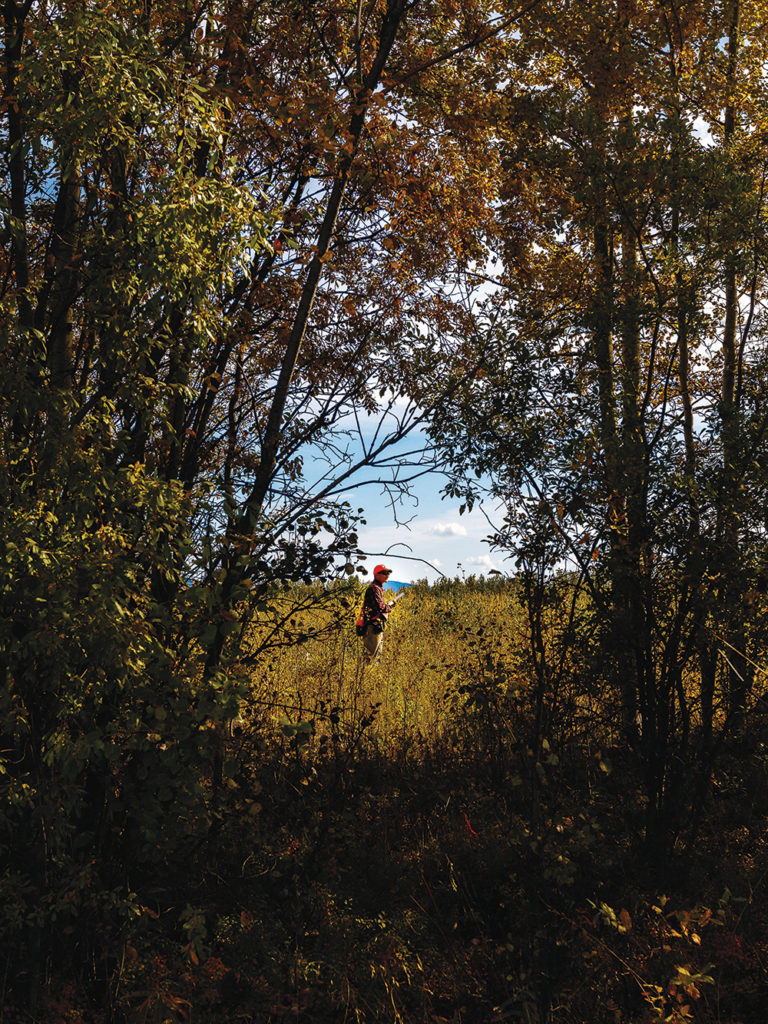A Dinosaur in Hand

The crisp coolness of an autumn morning in Interior Alaska was cause enough to have my bare hands searching for warm pockets after raising my wool collar up higher around my neck. In contrast, the two Brittany pointing dogs quartering the knee-high grass ahead of me welcomed such beginnings on a day forecasted to turn warm, too warm for fast-moving bird dogs covered in thick hair.
After an hour of brisk walking and several skirmishes with small coveys of sharp-tailed grouse, I was plenty warm and already finding relief in a cool breeze that had found its way here from the east out of Canada. Stopping to stand in the large expanse of grass before me, my eyes scanned the nearby snowcapped peaks of the Alaska Range, and I settled my gaze upon a glacier that clung to rugged peaks on either side. It’s natural to wonder how old the glacier was and what creatures roamed this place long before this bird hunter and his two now-resting bird dogs.
The grass where we hunted for grouse came as a result of hard work on the part of a farmer who cleared away the boreal forest only a few decades before, but it’s easy to let the mind travel back in time and wonder what Interior Alaska may have looked like thousands of years ago, and in particular, when did the ancestors to today’s grouse first appear.
I reached into my game bag and retrieved one of the sharp-tailed grouse my dogs had earlier found, pointed, and allowed me to shoot, and held it in my hand, admiring intricately colored and barred body feathers, polka-dotted wings, and trademark “sharp” tail feathers that conspicuously protruded from its body—certainly not a “T-Rex,” but an avian dinosaur nonetheless.

Scientists explain that during the Ice Age many different mammals lived in Interior Alaska, creatures like wooly mammoths, bison, musk ox, and horses, to name just a few, and that they arrived here from Eurasia by crossing the Bering Land Bridge. While most of the rest of North America was covered in ice, Interior Alaska was a vast, dry—either icy cold or blazing hot—steppe grassland where grazing creatures thrived. But as the Pleistocene Epoch was coming to an end, the Bering Land Bridge disappeared due to a change in climate and rising water levels around 13,000 years ago, and Alaska began to change into something similar to what we see around us today. The steppe grassland began to disappear, and the boreal forest began to grow and spread.
Scientific literature indicates the discovery of pea-sized polished stones some 11,000 years ago and suggests these were grit gathered by birds to aid in grinding food within their gizzards. Driving into my hunting destination early that morning, several grouse were out picking up grit alongside the road just as their ancestors had done many thousands of years prior in the company of those large prehistoric creatures, except not along a dirt road.
Mid-daydream, my gaze moved from yonder mountain glacier to the grass where the dogs had been lying only to notice them gone. Rested and cooled, the dogs had resumed hunting without me. And, it was time for me to do the same.
In short order, I saw both dogs quartering the grass out before me a few hundred yards away under an ever-brightening sky. It was getting much warmer, and I thought about calling in the dogs for a drink of water from bottles that I carry in my vest, but at that moment, first one dog and then the other ceased all forward movement and stood unmoving, noses thrust forward and obviously taking in the grouse scent they crave so much.

I put a move on and closed the distance quickly, knowing how these feathered rascals might just run out on the pointing dogs and plunge me into some sort of foot pursuit—eventually offering only shots that were on the edge of being out of range or beyond.
Drawing near to my steady dogs, I slowed my pace, readied my gun, and took a deep breath before moving around the dogs in an attempt to flank any grouse that may have been hunkered close to the ground and were hiding in the grass out front as they pondered their next move. The grouse had held well, the plan was a good one, and so were the two shots and the resulting retrieves to hand. Life was good.
As the earth changed and the steppe grasslands gradually disappeared, giving way to a forest habitat of birch, aspen, and spruce, Alaska’s sharp-tailed grouse adapted to those changes and appear to be thriving now, at least in the Interior region. The birds still require a more open, grassy habitat—like the CRP field in which I was hunting, wildfire burn areas (as much as a million acres of Alaska burns each year, mostly caused by lightning strikes), grassy muskegs, or along wilderness rivers or rights-of-way like backcountry roads, railways, pipelines, or power lines—but can also be found in open park-like areas deep within typical ruffed-grouse habitat.
Imagine, if you will, your dogs are hunting ruffed grouse in thick aspen and willow cover when they enter a large and somewhat open area where blueberries or kinnikinnick berries are in abundance, and they go on point. Could be a ruffed grouse? Might even be a spruce grouse? Or it could be three, or eight, or 15 sharp-tailed grouse that are about to flush and cause even the most seasoned hunter a moment of sheer panic and awesome pandemonium when cackling and erupting into flight all around you.
This is the stuff of dreams, I tell you.

The dogs and I seek refuge in the shade of tall aspens to drink water and enjoy a cool breeze while reflecting upon the morning’s magic and adventure. We enjoyed plenty of grouse encounters and points resulting mostly in clean escape by grouse that have honed their instincts for survival over the course of many thousands of years, but we also managed to place three grouse of a five-bird limit into my game vest, and for that, I felt quite grateful.
With the dogs no longer panting and up again and pacing about, I offered another sip of water to each before issuing a “hunt ’em up!” command and resuming our pursuit for these incredible grouse. Off in a flash, the dogs split up, and as one hunted the tall grass, the other zigzagged in and out of a two-mile-long, mostly aspen windrow, both places where these experienced bird dogs have found so many sharptails, and often a ruffed grouse, over the course of their hunting lives.
The next grouse find didn’t come soon, but after a few more miles of walking through the breathtaking surroundings, as flocks of Sandhill cranes flew low overhead and their haunting chatter was so loud as to distract, the dogs found grouse holding within the thickly wooded windrow. Although tired from a long day of walking, to witness a dog pointing to where grouse surely lie ahead is enough to bring life and energy back into my aging muscles and put some pep back into my step.
Once I could see both dogs and take note of the direction they were pointing, it was clear to me that this grouse, or these grouse as it turned out to be, would likely push through the trees and brush to flush out the opposite side if they absolutely were forced to do so. Some 50 yards shy of the two unmoving dogs, I cut through the windbreak and made my approach along the opposite edge.

Drawing near to where the grouse should have been hiding, my eye spied movement just as a mature male sharptail burst into flight. My leading hand began swinging the gun along the path of the rapidly departing grouse, and as the gun came first to my cheek, and then to my shoulder while the barrels passed through the bird, I fired the side-by-side 28-gauge shotgun.
The grouse crumpled and fell to the ground well out before me. Within moments one of the dogs found the grouse in the grass and was bringing it back to me, while the second dog had relocated on running birds before pinning them for the second time.
As I drew near to my dog, four or five grouse took to flight on my side of the windbreak, while I could hear the flushing and cackling of several others within the same windbreak but going out the other side. I swung the gun on the closest grouse, and it dropped to the ground. With my five-grouse limit reached, I opened my gun, unloaded the second round, and simply watched the other grouse fly away. My shooting for the day was over, but the dogs found and pointed even more grouse on our way back to the truck.
At the truck, the dogs were checked over for any injuries, watered, and fed a treat before being put back into their individual kennels where they settled in for a well-earned nap on the long drive home. After my gun was wiped and placed in its case and my other gear was stowed, I laid out the day’s take of grouse, picking up one and holding it in my hand.
My thoughts ranged from reenactments of the more adventurous moments of the day all the way back to what it must have been like when the ancestors of this grouse walked among dinosaurs—back to when the bird I held in my hand was itself a dinosaur. They’ve come a long way, and this bird hunter sure is happy that they did.
Originally published in Volume 10, Number 2 (Feb-May 2022) of Covey Rise.
























